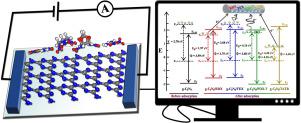当前位置:
X-MOL 学术
›
J. Phys. Chem. Solids
›
论文详情
Our official English website, www.x-mol.net, welcomes your
feedback! (Note: you will need to create a separate account there.)
Adsorption behavior of explosive molecules on g-C3N4 nanostructure: A novel approach for sensing energetic materials
Journal of Physics and Chemistry of Solids ( IF 4.3 ) Pub Date : 2021-02-01 , DOI: 10.1016/j.jpcs.2020.109777 B. Moses Abraham
Journal of Physics and Chemistry of Solids ( IF 4.3 ) Pub Date : 2021-02-01 , DOI: 10.1016/j.jpcs.2020.109777 B. Moses Abraham

|
Abstract Inspired by the latest achievements of two-dimensional (2D) materials as gas sensors, we have performed ab-initio calculations to simulate the interactions between the explosive molecules (RDX, TEX, FOX-7 and TATB) and g-C 3 N 4 surfaces in order to exploit the potential applicability of g-C 3 N 4 as explosive sensor. The adsorption energies and measured distances of g-C 3 N 4 /explosive configurations indicate that the TATB molecule interacts strongly with g-C 3 N 4 and produces more number of extra peaks within the Fermi level region. The calculated sensitivity (S) test also demonstrates the superior sensitivity of g-C 3 N 4 towards TATB molecule. Keeping other semiconducting materials like graphene and boron nitride in perspective, our calculations show higher binding energies when explosive molecules are adsorbed on g-C 3 N 4 with appropriate charge transfer, representing better sensitivity for the latter. An increased work function is obtained when planar TATB and FOX-7 molecules are placed on the g-C 3 N 4 surface. Further, the sensitivity of g-C 3 N 4 for these explosive molecules is interpreted in terms of electronic and optical properties, where the density of states and absorption spectra show marked variations when explosive molecules are adsorbed on g-C 3 N 4 surface. The significant overlap between the interacting atoms of adsorbate and adsorbent in PDOS spectra represents the formation of chemical bonds at the interface region. Our calculations demonstrate the adsorption and reactivity processes that occur at the interface region, being useful to develop and design devices with extreme sensitivity for explosive detection.
中文翻译:

爆炸物分子在 g-C3N4 纳米结构上的吸附行为:一种检测含能材料的新方法
摘要 受二维 (2D) 材料作为气体传感器的最新成果的启发,我们进行了从头计算来模拟爆炸分子(RDX、TEX、FOX-7 和 TATB)与 gC 3 N 4 表面之间的相互作用。为了开发gC 3 N 4 作为爆炸物传感器的潜在适用性。gC 3 N 4 /爆炸构型的吸附能和测量距离表明TATB 分子与gC 3 N 4 强烈相互作用并在费米能级区域内产生更多数量的额外峰。计算出的灵敏度 (S) 测试也证明了 gC 3 N 4 对 TATB 分子的卓越灵敏度。保持其他半导体材料,如石墨烯和氮化硼,我们的计算表明,当爆炸性分子以适当的电荷转移吸附在 gC 3 N 4 上时,结合能更高,这表明后者具有更好的灵敏度。当平面 TATB 和 FOX-7 分子放置在 gC 3 N 4 表面上时,可以获得增加的功函数。此外,gC 3 N 4 对这些爆炸物分子的敏感性是从电子和光学特性的角度来解释的,当爆炸物分子吸附在 gC 3 N 4 表面时,状态密度和吸收光谱显示出明显的变化。PDOS 光谱中吸附质和吸附剂的相互作用原子之间的显着重叠表示在界面区域形成了化学键。我们的计算证明了发生在界面区域的吸附和反应过程,
更新日期:2021-02-01
中文翻译:

爆炸物分子在 g-C3N4 纳米结构上的吸附行为:一种检测含能材料的新方法
摘要 受二维 (2D) 材料作为气体传感器的最新成果的启发,我们进行了从头计算来模拟爆炸分子(RDX、TEX、FOX-7 和 TATB)与 gC 3 N 4 表面之间的相互作用。为了开发gC 3 N 4 作为爆炸物传感器的潜在适用性。gC 3 N 4 /爆炸构型的吸附能和测量距离表明TATB 分子与gC 3 N 4 强烈相互作用并在费米能级区域内产生更多数量的额外峰。计算出的灵敏度 (S) 测试也证明了 gC 3 N 4 对 TATB 分子的卓越灵敏度。保持其他半导体材料,如石墨烯和氮化硼,我们的计算表明,当爆炸性分子以适当的电荷转移吸附在 gC 3 N 4 上时,结合能更高,这表明后者具有更好的灵敏度。当平面 TATB 和 FOX-7 分子放置在 gC 3 N 4 表面上时,可以获得增加的功函数。此外,gC 3 N 4 对这些爆炸物分子的敏感性是从电子和光学特性的角度来解释的,当爆炸物分子吸附在 gC 3 N 4 表面时,状态密度和吸收光谱显示出明显的变化。PDOS 光谱中吸附质和吸附剂的相互作用原子之间的显着重叠表示在界面区域形成了化学键。我们的计算证明了发生在界面区域的吸附和反应过程,











































 京公网安备 11010802027423号
京公网安备 11010802027423号